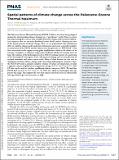Files in this item
Spatial patterns of climate change across the Paleocene–Eocene Thermal Maximum
Item metadata
| dc.contributor.author | Tierney, Jessica E. | |
| dc.contributor.author | Zhu, Jiang | |
| dc.contributor.author | Li, Mingsong | |
| dc.contributor.author | Ridgwell, Andy | |
| dc.contributor.author | Hakim, Gregory J. | |
| dc.contributor.author | Poulsen, Christopher J. | |
| dc.contributor.author | Whiteford, Ross D. M. | |
| dc.contributor.author | Rae, James W. B. | |
| dc.contributor.author | Kump, Lee R. | |
| dc.date.accessioned | 2022-10-27T12:30:13Z | |
| dc.date.available | 2022-10-27T12:30:13Z | |
| dc.date.issued | 2022-10-18 | |
| dc.identifier | 281845983 | |
| dc.identifier | 56db5b53-2dd0-476d-895b-1867eeda0e3a | |
| dc.identifier | 85139515772 | |
| dc.identifier.citation | Tierney , J E , Zhu , J , Li , M , Ridgwell , A , Hakim , G J , Poulsen , C J , Whiteford , R D M , Rae , J W B & Kump , L R 2022 , ' Spatial patterns of climate change across the Paleocene–Eocene Thermal Maximum ' , Proceedings of the National Academy of Sciences , vol. 119 , no. 42 , e2205326119 . https://doi.org/10.1073/pnas.2205326119 | en |
| dc.identifier.issn | 1091-6490 | |
| dc.identifier.other | RIS: urn:FD219A5FD6856BEA9D71CA489B9A8BB1 | |
| dc.identifier.other | ORCID: /0000-0003-3904-2526/work/121753924 | |
| dc.identifier.other | ORCID: /0000-0002-2178-3476/work/121754013 | |
| dc.identifier.uri | https://hdl.handle.net/10023/26261 | |
| dc.description | Funding: This study was supported by Heising–Simons Foundation Grants 2016-015 (to J.E.T.), 2016-011 (to M.L. and L.R.K.), 2016-013 (to A.R.), 2016-014 (to G.J.H.), and 2016-012 (to C.J.P.). R.D.M.W. and J.W.B.R. acknowledge funding from the European Research Council under the European Union’s Horizon 2020 Research and Innovation Program Grant 805246. This material is based on work supported by the National Center for Atmospheric Research (NCAR), which is a major facility sponsored by NSF Cooperative Agreement 1852977. Computing and data storage resources, including the Cheyenne supercomputer (https://arc.ucar.edu/knowledgebase/70549542), were provided by the Computational and Information Systems Laboratory at NCAR. | en |
| dc.description.abstract | The Paleocene–Eocene Thermal Maximum (PETM; 56 Ma) is one of our best geological analogs for understanding climate dynamics in a “greenhouse” world. However, proxy data representing the event are only available from select marine and terrestrial sedimentary sequences that are unevenly distributed across Earth’s surface, limiting our view of the spatial patterns of climate change. Here, we use paleoclimate data assimilation (DA) to combine climate model and proxy information and create a spatially complete reconstruction of the PETM and the climate state that precedes it (“PETM-DA”). Our data-constrained results support strong polar amplification, which in the absence of an extensive cryosphere, is related to temperature feedbacks and loss of seasonal snow on land. The response of the hydrological cycle to PETM warming consists of a narrowing of the Intertropical Convergence Zone, off-equatorial drying, and an intensification of seasonal monsoons and winter storm tracks. Many of these features are also seen in simulations of future climate change under increasing anthropogenic emissions. Since the PETM-DA yields a spatially complete estimate of surface air temperature, it yields a rigorous estimate of global mean temperature change (5.6 ∘C; 5.4 ∘C to 5.9 ∘C, 95% CI) that can be used to calculate equilibrium climate sensitivity (ECS). We find that PETM ECS was 6.5 ∘C (5.7 ∘C to 7.4 ∘C, 95% CI), which is much higher than the present-day range. This supports the view that climate sensitivity increases substantially when greenhouse gas concentrations are high. | |
| dc.format.extent | 7 | |
| dc.format.extent | 2371903 | |
| dc.language.iso | eng | |
| dc.relation.ispartof | Proceedings of the National Academy of Sciences | en |
| dc.subject | Paleocene-ecocene thermal maximum | en |
| dc.subject | Greenhouse climates | en |
| dc.subject | Climate sensitivity | en |
| dc.subject | Hydrological cycle | en |
| dc.subject | Data assimilation | en |
| dc.subject | GE Environmental Sciences | en |
| dc.subject | DAS | en |
| dc.subject | SDG 13 - Climate Action | en |
| dc.subject | MCC | en |
| dc.subject.lcc | GE | en |
| dc.title | Spatial patterns of climate change across the Paleocene–Eocene Thermal Maximum | en |
| dc.type | Journal article | en |
| dc.contributor.sponsor | European Research Council | en |
| dc.contributor.institution | University of St Andrews. School of Earth & Environmental Sciences | en |
| dc.contributor.institution | University of St Andrews. Centre for Energy Ethics | en |
| dc.contributor.institution | University of St Andrews. St Andrews Isotope Geochemistry | en |
| dc.identifier.doi | https://doi.org/10.1073/pnas.2205326119 | |
| dc.description.status | Peer reviewed | en |
| dc.identifier.grantnumber | 805246 | en |
This item appears in the following Collection(s)
Items in the St Andrews Research Repository are protected by copyright, with all rights reserved, unless otherwise indicated.

